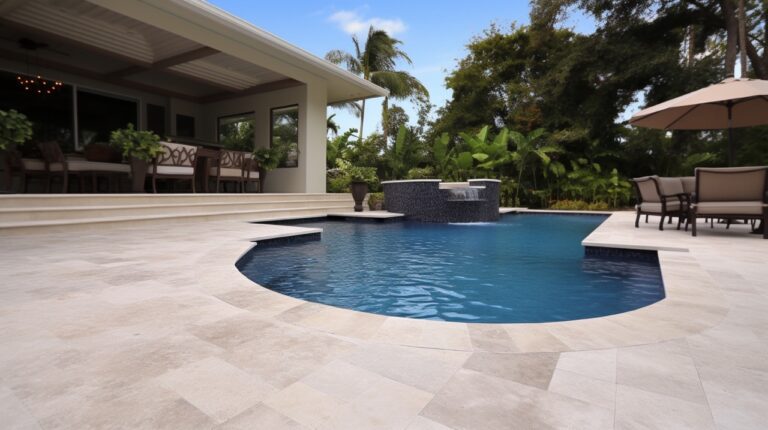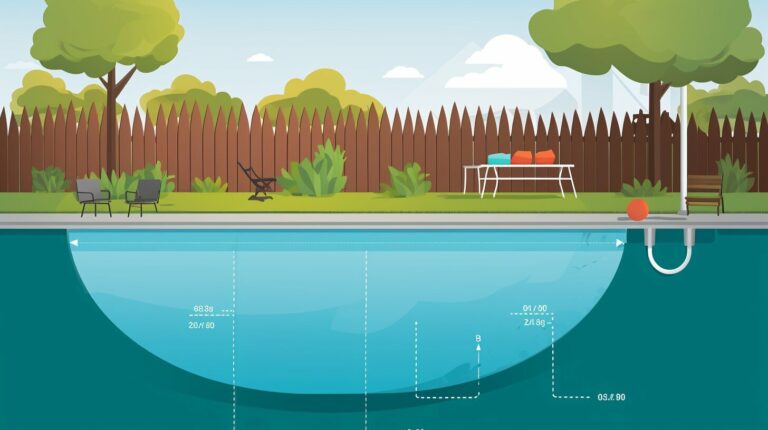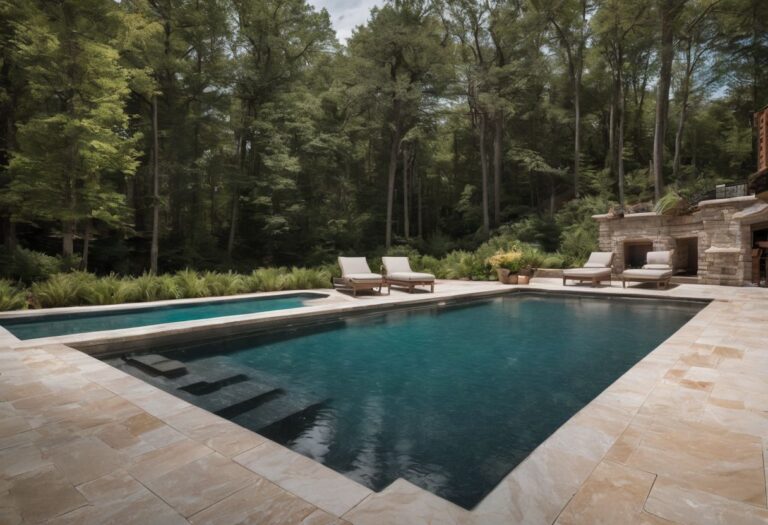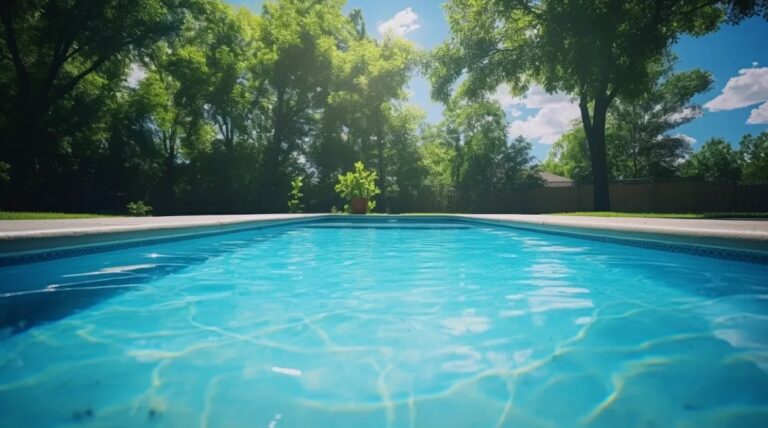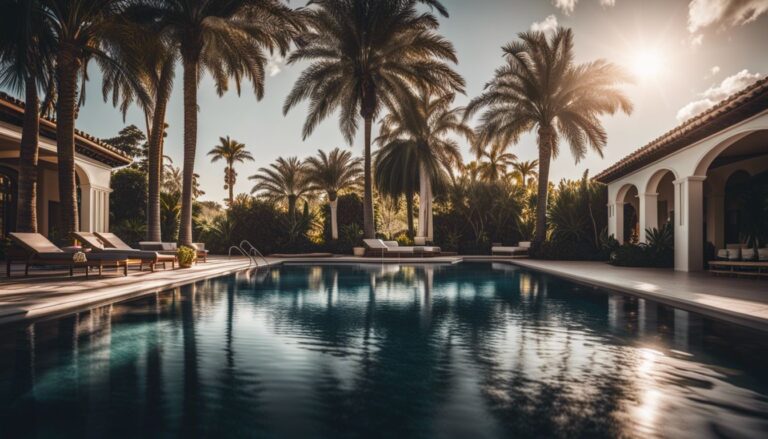Can You Have A Pool With A Well? Things To Know About Water
Intro: Can You Have A Swimming Pool With Well Water?
So, you’re thinking about building a dreamy backyard oasis complete with a large pool, hot tub, and garden hose, but you’re drawing your water from a well. You might ask yourself, “Can you have a pool with a well?” The answer is yes, but it comes with a boatload of things to consider, from the well’s flow rate and water quality to pool equipment and maintenance. This comprehensive guide will address all your questions and concerns, diving deep into the world of well-fed pools.
Well Water: An Abundance of Benefits and Challenges
When it comes to using well water for your pool, there are numerous benefits and challenges that pool owners need to weigh before diving in. This section will expand on the pros and cons associated with well water.
Pros of Using Well Water
Cost savings: One of the most attractive advantages of using well water is the potential cost savings. Tapping into your water supply means you won’t be paying for municipal water to fill and maintain your pool. This can save you significant money, especially during the peak swimming season when water usage is high.
Self-sufficiency: Having your own water source provides a sense of self-sufficiency and independence. You won’t be relying on the city’s water system, which can be affected by droughts, water rationing, or other restrictions. In the long run, this self-reliance can be empowering and satisfying.
No municipal water restrictions: Since you’re using your water supply, you won’t be subject to municipal water restrictions, which can limit pool usage during drought or water shortages. This means you can enjoy your pool and keep it filled without worrying about running afoul of local regulations.
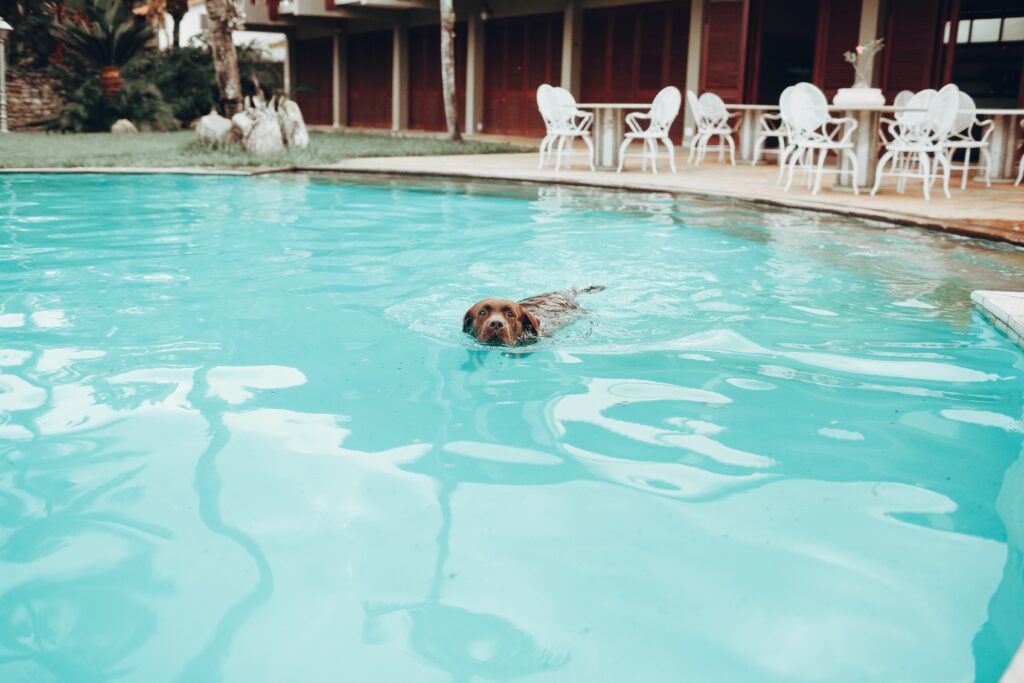
Cons of Using Well Water
Potential water quality issues: Well water can sometimes have issues with water quality, such as high mineral content, bacteria, or other contaminants. Hard water, in particular, can lead to calcium deposits on pool surfaces and equipment, requiring more maintenance and potentially causing damage over time. Also, bacteria growth and other water quality issues may require more aggressive treatment methods, such as higher chlorine concentrations or specialized filtration systems.
Fluctuating water levels: Depending on the size of your pool and the water table in your area, using well water can lead to fluctuating water levels. If your well’s flow rate is low or the water table drops during dry seasons, you may struggle to maintain the desired water level in your pool. This can also stress your well pump and other equipment, as it works harder to provide the necessary water.
The strain on well pump and equipment: Filling and maintaining a pool can considerably strain your well pump and other equipment. Pool water requires a constant flow of fresh water to maintain water chemistry and cleanliness, and this increased demand can cause your well pump to work harder, shortening its lifespan. Moreover, the pool pump and filtration system may require more power and maintenance.
High water usage: Swimming pools, especially large ones, can consume significant water. This high water usage may strain your well’s capacity and affect the water supply for the rest of your home. Before installing a pool, it is crucial to assess your well’s flow rate and ensure it can handle the increased water demand without causing issues for other household water needs.
Assessing Your Well’s Capacity
Before you jump into building a pool with well water, it’s essential to assess your well’s capacity to ensure it can meet the demands of a swimming pool. This involves evaluating the flow rate, water level, and water quality.
Flow Rate and Gallons of Water
Low flow rate vs. high flow rate: Your well’s flow rate refers to the gallons of water it can produce per minute (GPM). A low flow rate may struggle to provide enough water to fill and maintain your pool, while a high flow rate can meet the demands more efficiently. It’s crucial to know your well’s flow rate and consider it when planning the size of your pool and the necessary equipment.
Sizing your pool pump: The pump is responsible for circulating water through the filtration system, ensuring the water stays clean and properly treated. The size of your pool pump should be based on the size of your pool and the flow rate of your well. If your well has a low flow rate, you may opt for a smaller pool or consider installing a storage tank to ensure your pump can operate effectively.
Water Level and Storage
Well water table considerations: The water table in your area can impact your well’s capacity to provide water for your pool. In areas with a high water table, wells can generally supply more water, while low water tables can lead to water shortages and difficulty maintaining pool water levels. Keep an eye on your local water table levels and consider installing a monitoring system to help you stay informed about potential fluctuations.
Pressure tanks and storage tanks: If your well has a low flow rate or you live in an area with a fluctuating water table, you may need to consider installing a tank or storage tank. These tanks can store water when your well’s flow rate is higher, providing a buffer during low flow periods. This ensures that you always have enough water to meet the demands of your pool and other household needs.
Testing the Waters: Quality Matters
Hard water and calcium hardness: Well water often contains minerals like calcium and magnesium, which can lead to hard water. High calcium hardness levels in pool water can cause scaling on pool surfaces, equipment, and clog filters. To prevent these issues, test your well water for calcium hardness and treat it accordingly, using water softeners or other treatments as needed.
Bacteria growth and treatment options: Well water can sometimes harbor bacteria, algae, and other microorganisms that can risk swimmers’ health. Regular testing and treatment of your pool water are essential to prevent these issues. Options include using chlorine-based water treatment systems, UV sanitizers, or ozone generators to keep your pool water safe and clean.
pH levels, free chlorine, and cyanuric acid: Balancing your pool water’s chemistry is crucial for maintaining a healthy swimming environment. Test your well water for pH, free chlorine, and cyanuric acid levels, and adjust them as needed to maintain the proper balance. This can help prevent corrosion, scaling, and algae growth, ensuring your pool remains safe and enjoyable swimming place.
How Long Does It Take To Fill A Pool?
Pool Fill Time Calculator
A typical well-water flow rate can vary depending on well depth, pump capacity, and local geology. However, a common range for residential wells is between 5 and 25 gallons per minute (gpm). Keep in mind that this is just a general guideline, and actual flow rates can be higher or lower based on individual circumstances.
Pool Gallons Calculator
Where Can I Get My Water Tested?
You can get your water tested at various places, such as:
Local pool supply store: Many pool stores offer water testing services and can provide guidance on maintaining proper water chemistry in your pool.
Independent water testing laboratories: Search online or check your local directory for water testing labs in your area. They can analyze your water sample and provide a detailed report on its quality.
County or state health department: Some local health departments offer water testing services, especially for well water. Check their websites or call them to inquire about testing options and fees.
Home water testing kits: You can purchase water testing kits from pool supply stores or online retailers. One of the best quality kits we recommend is the TF Test Kits.
Pool Types and Materials: Making a Splash
When it comes to building a pool with well water, the type and material of your pool can play a significant role in how well it suits your needs. This section will explore the different pool types and materials, discussing their pros and cons.
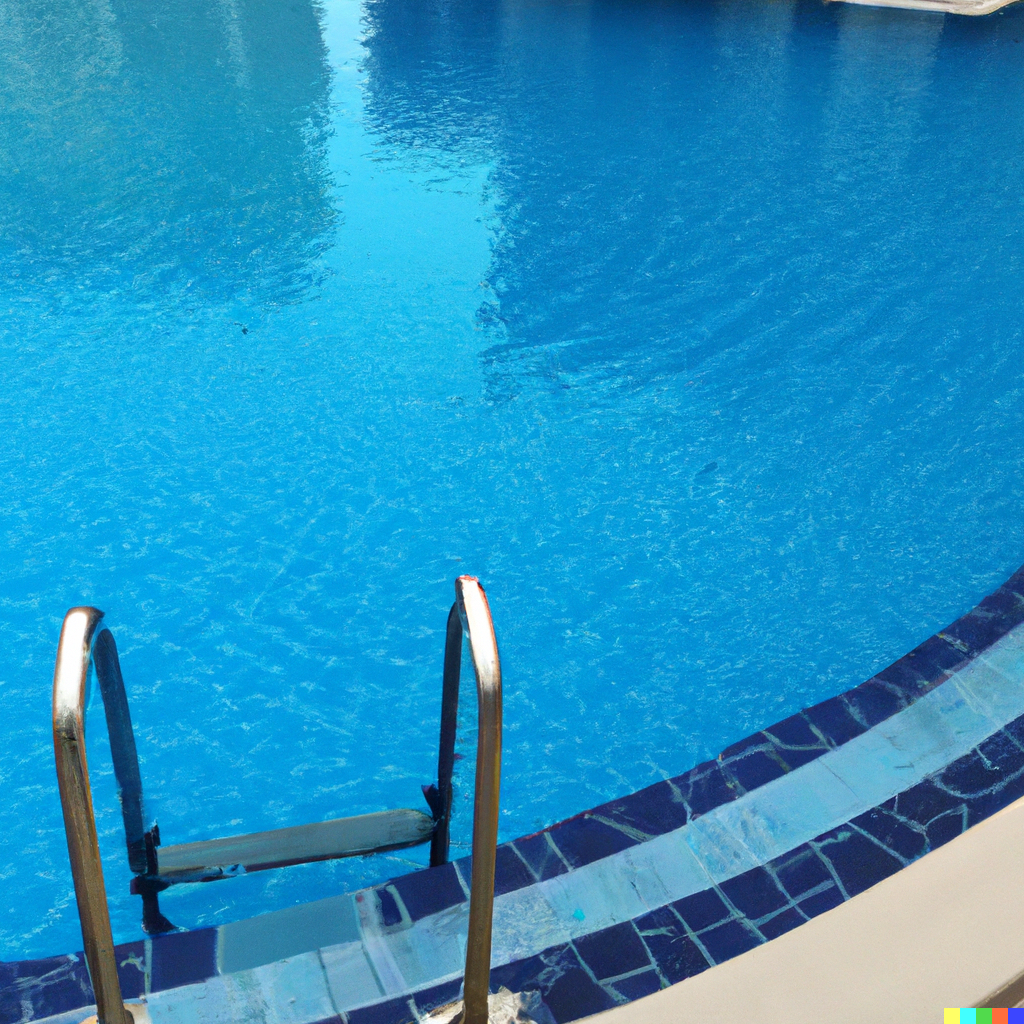
Inground Pools
Vinyl pools are a popular choice due to their affordability and customizable designs. They feature a vinyl liner over a steel or polymer frame, which can be easily replaced if damaged. However, the liners can be prone to punctures and may require more frequent maintenance or replacement than other materials. Vinyl pools can work well with well water, but you should regularly monitor water chemistry to prevent damage to the liner.
Fiberglass pools: Fiberglass pools are pre-manufactured shells installed into a prepared hole in your backyard. They offer a low-maintenance option, with a smooth surface that resists algae growth and requires fewer chemicals. Fiberglass pools work well with well water, as their non-porous surface helps prevent staining and scaling from mineral deposits. However, they can be more expensive than vinyl pools and may have limited design options.
Concrete pools: Concrete pools, also known as gunite or shotcrete pools, are highly customizable and can be built virtually any shape or size. They’re often considered the most durable option, with a long-lasting surface that can be finished with plaster, tile, or aggregate. However, concrete pools can be more susceptible to staining and scaling from hard well water, requiring diligent monitoring of water chemistry and more frequent maintenance.\
Above-Ground Pools
Above-ground pools are economical and versatile for pool owners with well water. They come in various sizes and shapes, with materials ranging from steel to resin. Above-ground pools can be installed quickly, sometimes within a day, and even moved or disassembled. The main drawback is that they typically have a shorter lifespan than inground pools and may be less visually appealing. Nevertheless, with proper maintenance and water chemistry, above-ground pools can be a great option for those using well water.
Hot Tubs and Spas
In addition to swimming pools, hot tubs, and spas can also be used with well water. These smaller features require less water to fill and maintain, benefiting well owners with low flow rates or fluctuating water tables. Hot tubs and spas often have built-in filtration and treatment systems, making them relatively low maintenance. However, the higher water temperature in hot tubs can lead to increased mineral scaling and faster evaporation, so it’s essential to regularly test and adjust the water chemistry to keep everything in balance.
Pool Equipment: Your Well-Watered Arsenal
When using well water for your pool, it’s essential to have the right equipment to ensure it stays clean, well-maintained, and safe for swimming. This section will explore the different types of pool equipment you’ll need when using well water.
Pumps and Filtration Systems
Submersible and sump pumps: Submersible pumps are designed to work underwater and can effectively choose well water pool systems. Submersible sump pumps can remove excess water from your pool area, preventing flooding or water damage. They’re particularly useful in areas with high water tables or during periods of heavy rain.
Sand filters, cartridge filters, and DE filters: A well-functioning filtration system is crucial for maintaining clean and clear pool water. Sand filters use sand to trap debris, while cartridge filters use pleated fabric or paper to catch particles. DE (diatomaceous earth) filters use a fine powder to filter out even smaller particles. Each type of filter has its maintenance requirements, so choosing one that suits your needs and water conditions is essential.
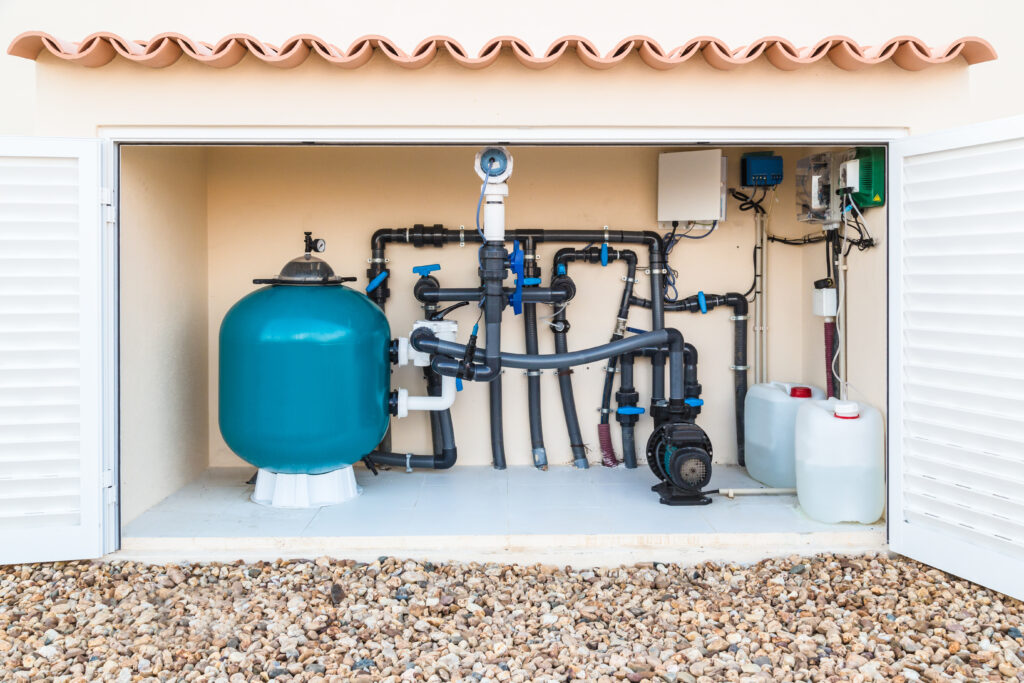
Water Softeners and Treatment Systems
Ion exchange water softeners: Ion exchange water softeners are popular for treating hard well water. They work by replacing calcium and magnesium ions with sodium ions, softening the water, and reducing the risk of scaling and other issues related to hard water.
Salt-free water conditioners: Salt-free water conditioners offer an alternative to traditional water softeners, using a physical process to alter the structure of minerals in the water, preventing them from forming scale. They can be a good option for those who want to avoid adding salt to their pool water.
Chlorine-based water treatment systems: Chlorine is a common method for treating pool water, effectively killing bacteria and other harmful microorganisms. Chlorine-based treatment systems can be used with well water. Still, it’s important to carefully monitor chlorine levels and adjust them as needed to maintain a safe and healthy swimming environment.
Testing and Monitoring
Test strips and kits: Regular pool water testing is crucial when using well water. Test strips and kits are easy to monitor your water’s pH, chlorine, and other chemical levels, ensuring your pool stays balanced and safe for swimming. Keep a supply of test strips or a test kit on hand, and test your water frequently to stay on top of any issues.
Electronic pool water monitoring systems: Electronic pool water monitoring systems offer a more advanced and convenient way to track your pool water’s chemical levels. These systems use sensors to monitor your water chemistry and can even send alerts to your smartphone or other devices when adjustments are needed. This can help you maintain a healthy pool with minimal effort, even when using well water.
Maintaining Your Well-Fed Pool: Tips and Tricks
Keeping your well-fed pool in tip-top shape requires regular maintenance and attention to detail. Here are some essential tips and tricks to help you maintain a clean, healthy, and inviting pool using well water.
Regular Water Testing
Frequent water testing is crucial for ensuring your pool water stays balanced and safe for swimming. If you notice any issues, test your pool water at least once a week or more frequently. Be sure to test for pH, calcium hardness, metal content, chlorine concentration, and cyanuric acid levels.
Balancing Water Chemistry
Adjusting pH levels: Maintaining the proper pH level in your pool is essential for preventing damage to your pool surfaces, equipment, and swimmers’ skin and eyes. Ideally, your pool water’s pH should be between 7.4 and 7.6. Test regularly and use pH increasers or decreasers to maintain the correct balance.
Managing calcium hardness and metal content: High calcium hardness levels in well water can lead to scaling and other issues. Use a water softener or other treatment to manage calcium hardness, and consider using a metal sequestrant to prevent staining and other problems related to high metal content.
Monitoring chlorine concentration and cyanuric acid levels: Maintaining the appropriate chlorine concentration is crucial for preventing bacteria and algae growth. The ideal range is 1-3 parts per million (ppm). Also, monitor cyanuric acid levels, which help stabilize chlorine in outdoor pools, aiming for a 30-50 ppm range.
Preventing Common Problems
Cloudy water and murky water: Cloudy or murky water can be caused by a variety of factors, including poor filtration, imbalanced water chemistry, or debris in the pool. Address these issues by cleaning your filter, balancing water chemistry, and removing debris.
Bacteria growth and algae blooms: Regularly testing and treating your pool water can help prevent bacteria growth and algae blooms. Be vigilant about maintaining proper chlorine levels and consider using algaecides or other necessary treatments.
Pool liner and surface damage: Well water’s high mineral content can lead to pool liner and surface damage. To prevent this, maintain proper water chemistry and consider using a water softener or other treatment to manage mineral levels.
Seasonal Care
Preparing for warmer months: As the weather warms up, you’ll need to adjust your pool maintenance routine to account for increased evaporation, algae growth, and other seasonal challenges. Increase the frequency of water testing, and be prepared to adjust your water chemistry as needed.
Winterizing your pool: Properly winterizing your pool can help prevent damage and make reopening in the spring much easier. Drain the water below the skimmer level, add winterizing chemicals, and cover your pool with a winter cover to protect it from the elements.
Using a security cover or winter cover: A security cover or winter cover can help protect your pool from debris, evaporation, and damage during the off-season. Choose a cover that fits your pool’s shape and size, and make sure it’s securely fastened to prevent accidents and keep your pool in good condition.
FAQs: Well Water and Pool Care
Q: Is using well water for a pool a good idea?
A: Using well water for a pool can be a good idea if your well can supply enough water without straining the well’s pump or depleting the water table. Be prepared to address potential water quality issues like hardness and mineral content.
Q: How much water does a square foot of pool space require?
A: A square foot of pool space requires approximately 7.5 gallons of water per foot of depth. To estimate the amount of water needed, multiply the pool’s square footage by its average depth, then by 7.5.
Q: How can I improve the water quality in my well-fed pool?
A: Regular testing and adjusting your pool’s water chemistry, using a proper filtration system, and treating your well water with water softeners or other treatments can help improve water quality.
Q: What should the water pH be in my pool?
A: The ideal pH for pool water is between 7.4 and 7.6, ensuring a comfortable swimming environment and preventing damage to pool surfaces and equipment.
Q: What’s the first step in setting up a small pool using well water?
A: The first step is assessing your well’s capacity and water quality. Test your well water to determine if it’s suitable for use in a pool, and ensure your well can provide enough water without straining the pump or depleting the water table.
Q: Can my local pool store help me maintain well water pool?
A: Yes, your local pool store or pool supply center can provide guidance, products, and services to help you maintain a healthy swimming pool using well water.
Q: How much money can I save using well water for my pool?
A: The amount of money you can save depends on local water rates and the size of your pool. Using well water can save you hundreds or even thousands of dollars on your water bill.
Q: Can I use a fire department to fill my new pool?
A: In some areas, fire departments offer pool-filling services for a fee. Contact your local fire department for this service and any associated costs.
Q: What are some important considerations for using well water in an inground pool?
A: Some important considerations include ensuring your well can supply enough water, addressing potential water quality issues, choosing appropriate pool materials, and selecting suitable equipment.
Q: What filter system should I use for my well-fed pool?
A: Use sand, cartridge, or diatomaceous earth (DE) filters for your well-fed pool. Each type has advantages and drawbacks, so choose one based on your needs, pool size, and well water quality.
Q: Can many things go wrong when using well water for a pool?
A: There can be challenges like water quality issues and well capacity limitations. However, these issues can be mitigated with proper planning, regular maintenance, and appropriate equipment.
Q: What is the ideal body temperature for swimming pool water?
A: Most people find pool water comfortable at around 78-82°F (26-28°C), close to the average body temperature.
Q: Is well water the only way to fill a pool in the United States?
A: No, you can also fill a pool using municipal water, trucked-in water, or even water from a fire department (if available). Well water is just one of the options.
Q: Can I use a sand filter with my well-fed pool?
A: Yes, sand filters are suitable for well-fed pools. They effectively remove debris and are relatively low-maintenance. However, they may not remove very fine particles, so that additional water treatments may be necessary.
Q: What is the easiest way to fill a pool using well water?
A: The easiest way is to use a garden hose connected to your well’s water pump. Remember that this method can take a long time, especially for larger pools or if your well has a low flow rate.
Q: Can spa owners in warm climates use well water?
A: Spa owners in warm climates can use well water for their hot tubs, provided they address water quality issues and ensure their wells can supply sufficient water.
Q: Where can I get help and supplies for my well-fed pool?
A: Your local pool supply center can provide guidance, products, and services to help you maintain a healthy swimming pool using well water.
Q: Can I use well water for a water feature in my pool?
A: You can use well water for pool features like fountains and waterfalls. However, ensure your well can handle the additional water usage.
Q: Does using well water affect water pressure in an above-ground pool?
A: The water pressure in an above-ground pool depends on the pool’s height and the pump used to circulate water. Water should not significantly impact pressure if your good pump is adequately sized.
Q: Can well water cause health problems in a pool?
A: If untreated, well water may contain contaminants that can cause health issues. Regularly test and treat your well water to maintain a safe and healthy swimming environment.
Q: What is the average cost of using well water for a pool?
A: The cost of using well water for a pool depends on factors such as local water rates, pool size, and the capacity of your good pump. Using well water can save you hundreds or even thousands of dollars on your water bill.
Q: Can I use well water to supply a pool water pump?
A: You can use well water to supply a pool water pump. However, ensure your good pump can provide enough water for both the pool and your household
Conclusion: Can You Have A Pool With A Well
While it’s true that having a pool with a well can be a bit more complicated than using city water, it’s entirely possible with the right equipment, planning, and maintenance. Thanks for reading; contact us for any questions or comments.

